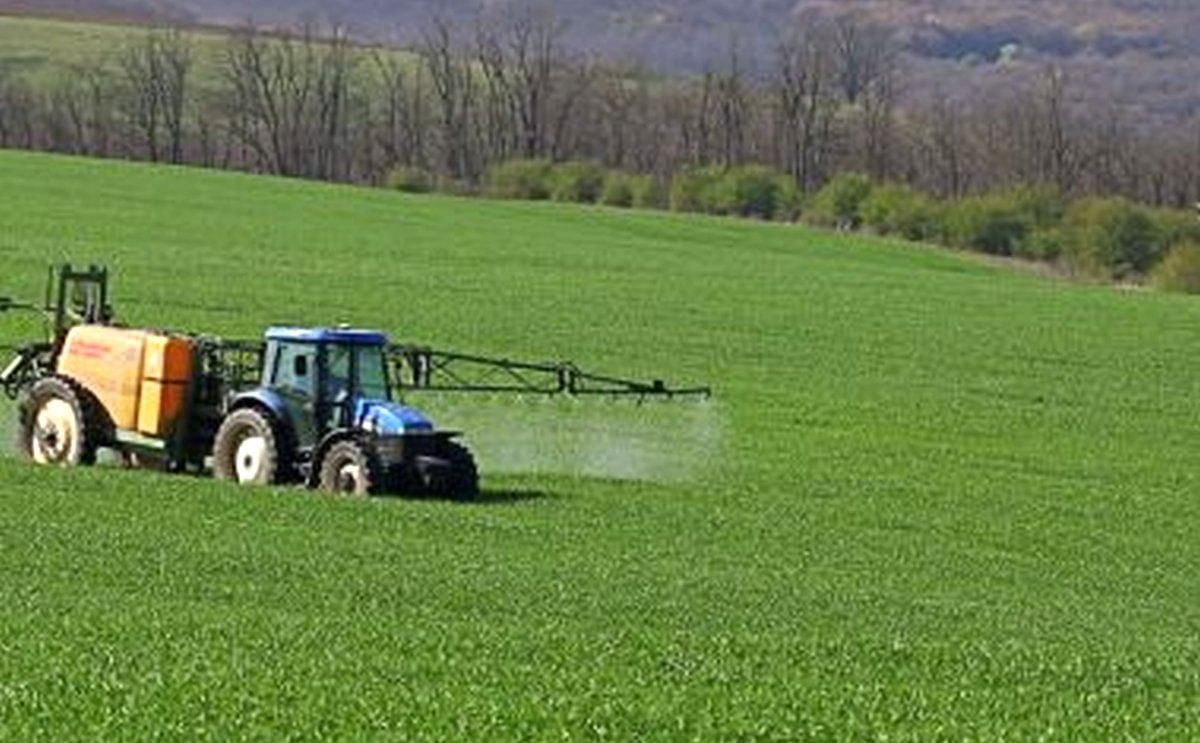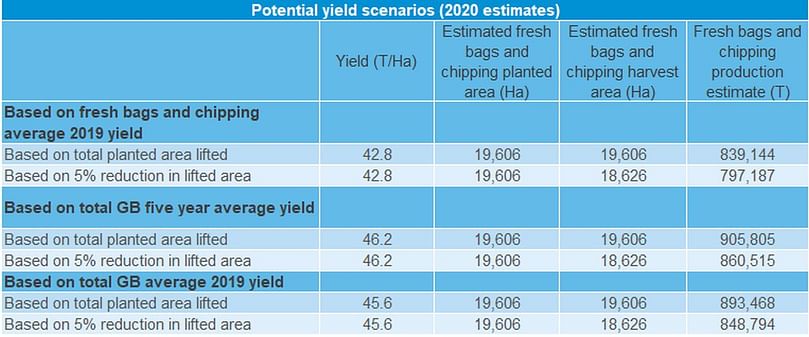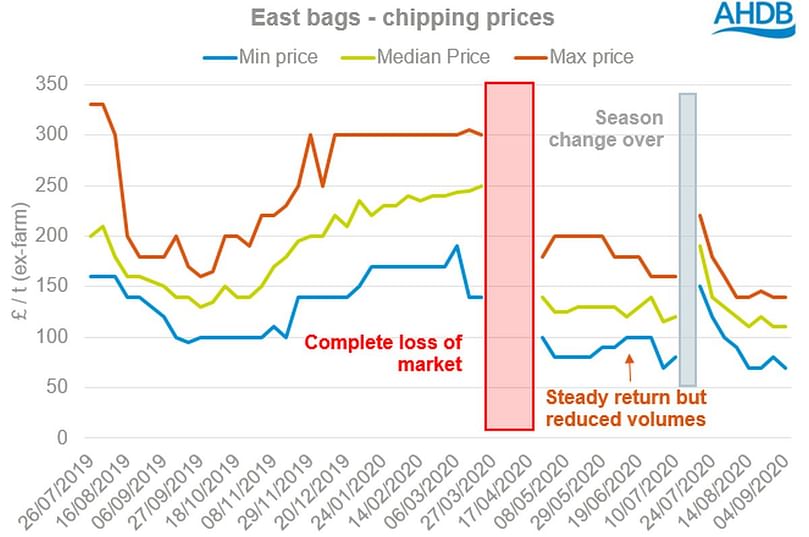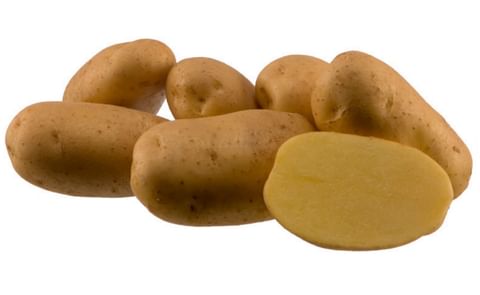AHDB: Taking a look at UK's chipping markets from a supply and demand perspective.
AHDB: Taking a look at UK's chipping markets from a supply and demand perspective.

With the coronavirus pandemic hitting the UK domestic potato trade, we have estimated a 1% drop year-on-year in the GB potato area for 2020/21, with the provisional area standing at 119Kha.
Almost all farmers and growers had committed to seed, fertilisers, and machinery in preparation as covid-19 swept across Europe sending the continent into a state of lockdown.
This has been disastrous for our domestic bag market which has felt a significant ongoing pressure since the end of March.
Not a tremendous amount of 2019 chipping potatoes were left as we entered 2020 cropping year. We did see free-buy bagging prices severely pressured from when new-crop lifting commenced, as supplies exceeded demand significantly.
In this article we will aim to:
- Forecast our potential chipping area for the 2020/21 marketing year.
- Review pricing of chipping potatoes since covid-19.
- Furthermore, demand going forward and how this could affect the ex-farm price of chipping potatoes.
A look at the supply side of chipping markets
The area of fresh bags (6.1Kha) and chipping (13.7Kha) potatoes in 2019 was at 19.8Kha, accounting for 16.5% of total planted GB potato area.
From this we can expect that the area of fresh bags (31%) and chipping (69%) will account for c.19.6Kha of the 2020 area.
Based on this figure and using a five-year average yield of 46.2t/ha, we may see the volume of GB fresh bag and chipping potatoes at around 905.8Kt this season if there are minimal area losses.
What is critical to note is there is a large degree of lifting still left to do, therefore weather events (as experienced last year) could change this figure.
In the table above is the possible supply scenario outlook for the fresh bags/chipping sector for the 2020/21 season.
But what is a critical note, is that without an extreme weather event we have a large supply of bags/chipping potatoes coming onto the market, which depending on Covid restrictions going forward may not be met with a certain level of demand.
Demand: What has happened and a look forward
From the end of March, through the beginning of the 'new crop' season back in July and for the near future, prices for chipping material have fallen to lower levels than in previous season openings. Coronavirus social distancing measures have reduced the influx of customers to chipping markets and so demand levels have fallen to lows for the summer months.
Other than a few rainfall events in August, the new crop potato harvest has been relatively unaffected and with average yields reported, the supply has mounted for chipping markets.
With low levels of demand, and relatively high levels of supply, prices have declined below the £100.0/t mark in many chipping markets, particularly in the West region.
Though, variety samples with premium fry quality have been able to access the higher prices above this mark. Varieties including Agria, Sagitta and, in some cases Maris Piper, are such examples.
Over August, we have seen prices start to increase slightly from the beginning of the month. The implementation of the government 'Eat out to Help out' voucher scheme has bolstered pub and restaurant trade with the scheme used for over 100 million meals.
However, restaurants that did not have, or did not open, 'eat-in' facilities were unable to sign up for the scheme. Many fish and chip shops are in this category of 'takeaway' restaurants and so reportedly saw a lower level of footfall, with consumers instead opting for the discounted meal options.
The rise in popularity of 'Staycations' has also increased this summer. With many people unable or unwilling to travel abroad, holidays within the UK became the preferred option.
Anecdotal reports from industry suggest some coastal regions had close to a 'normal' seasonal demand for fish and chip shops during the sunnier days of late July and early August.
Pricing
Throughout the first months of 2020, bagged chipping prices had been on a steady increase. The poorer weather that disrupted maincrop harvest heavily affected frying quality levels. As the graph below shows, right up until the end of March, median prices were averaging £232.85/t over January and February.
Though with the closure of the food service sector, prices then fell away in tandem with plummeting demand levels. Throughout the first few weeks of April, we were unable to publish an East bags price due to the minimal levels of trade being conducted.
New crop bag chipping prices initially started strong in July as the first tonnages reached markets. However, as more supply became available to suppressed demand levels, prices have fallen away.
Towards the end of August there were feelings in markets that with lockdown measures easing, a degree of price support would start to filter into markets as demand levels pick up.
Developing indications of a second lockdown
However, one developing news point currently, is the coronavirus infection rate starting to increase again. There have been several regional lockdowns put into place recently which seems to suggest this could be the plan rather than a whole nationwide lockdown.
The risk of a second food service closure has worried purchasers. Anecdotal reports indicate the approach is to wait for further information before committing large volume purchases in case they are required to close.
A second food service closure would heavily pressure chipping markets once again, particularly with the arrival of the maincrop harvest over the next few weeks.
Coastal fish and chip shops throughout September typically see an uptick in elderly tourist movement, though this looks to be curtailed by the coronavirus pandemic, especially with the rise in infection rates currently.
This will likely keep a weight on demand levels for many coastal tourist destinations.
Over the next few months, there are some watch-points to keep in mind for the direction of potato prices in chipping markets.
- Currently, headline news is the rise in infection rates across the UK. At this stage, it seems likely further lockdown measures will be implemented and regional lockdowns start to be enforced. Though at this moment it is unclear what will happen to the food service industry with a second lockdown. It will no doubt have a negative effect on demand as tourist confidence declines.
- Though this may seem further away currently, there is potential for consumer confidence to return, incentivising more meal occasions out of home. Prices will see support from better levels of demand. Though this will occur gradually over time, and is heavily dependent on lockdown measures easing and potential coronavirus vaccine implementation.














